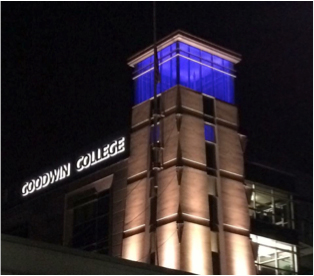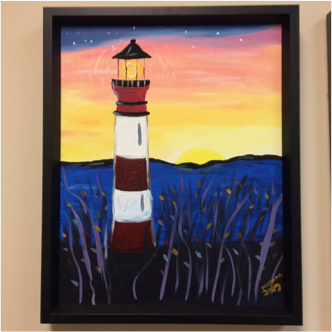Goodwin College’s Vision Care Technology program had their annual Paint Night fundraiser in November. These fundraisers provide the means to send students to optical conferences around the nation. This year our administrative assistant, Sara, chose a lighthouse as the subject. Little did she know the connection that lighthouses have with opticians.
 Lighthouses, Fresnel and prism. What do these three words have in common? Safety and sight! In 1819, French physicist Augustin-Jean Fresnel was charged with improving French lighthouses. He determined that by adding a lens in front of a beam of light, the light would be magnified. The lens needed for a lighthouse would have to be very large, thick, and heavy. That was not practical, so Fresnel developed a revolutionary lens that would transform lighthouses and ophthalmic lenses. According to the Cape Hatteras National Seashore, “Fresnel’s lens resembles a giant beehive with a complex system of multi-faceted glass prisms mounted in a brass framework. The prisms reflect and refract light, and magnify it, thereby taking rays of light that would normally scatter in all directions and focusing them into a single beam.” Fresnel knew that optical properties were dependent on the curve of the lens surface. He removed segments of the curve and brought those pieces down, keeping the properties of the lens while making it less thick. The center curve of the lens is constant, but the periphery is made up of small prismatic wedges. The optical properties remain the same, all with a thinner lens. The lighthouse beams could now reach from 8-10 miles to more than 20 miles away.
Lighthouses, Fresnel and prism. What do these three words have in common? Safety and sight! In 1819, French physicist Augustin-Jean Fresnel was charged with improving French lighthouses. He determined that by adding a lens in front of a beam of light, the light would be magnified. The lens needed for a lighthouse would have to be very large, thick, and heavy. That was not practical, so Fresnel developed a revolutionary lens that would transform lighthouses and ophthalmic lenses. According to the Cape Hatteras National Seashore, “Fresnel’s lens resembles a giant beehive with a complex system of multi-faceted glass prisms mounted in a brass framework. The prisms reflect and refract light, and magnify it, thereby taking rays of light that would normally scatter in all directions and focusing them into a single beam.” Fresnel knew that optical properties were dependent on the curve of the lens surface. He removed segments of the curve and brought those pieces down, keeping the properties of the lens while making it less thick. The center curve of the lens is constant, but the periphery is made up of small prismatic wedges. The optical properties remain the same, all with a thinner lens. The lighthouse beams could now reach from 8-10 miles to more than 20 miles away.The connection between lighthouses and opticians is press-on prism, also known as Fresnel Prism. Press-on prism is made of polyvinyl chloride, 1 mm thick in prismatic dioptric powers, ranging from 1.00 to 40.00. Imagine 6, 10, 15, 20, even 40 diopters of prism only 1 mm thick! The press-on prism (3M Press-On Optics) that we are familiar with is based on lens optics from the 1800’s. Fresnel’s work saved many at sea by extending the beam of light further from shore. Little would he know that his work to improve lighthouses would later improve the sight of thousands of people with strabismus, diplopia, phorias, nystagmus, rehabilitation of head trauma and stroke patients, and bed ridden patients.

Painting by Maryann Santos













